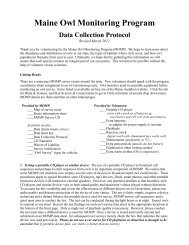Focus Species Forestry - Maine Audubon
Focus Species Forestry - Maine Audubon
Focus Species Forestry - Maine Audubon
Create successful ePaper yourself
Turn your PDF publications into a flip-book with our unique Google optimized e-Paper software.
Forest Threats and <strong>Species</strong> Selection<br />
The ideal suite of focus species is one that assures that no other species or ecosystem types<br />
compatible with managed forests are lost. Thus, threats to the forest were critical when the<br />
advisory committee selected focus species. The primary threats identified by the committee<br />
included:<br />
• Mature and late-successional forest fragmentation and loss, especially on large<br />
commercial timberlands;<br />
• Loss of very young forest, particularly in parts of southern <strong>Maine</strong> where the forest is<br />
maturing and light partial harvests are common 1 ;<br />
• Simplification of the forest, in particular the decline in standing dead and down trees<br />
where “clean” silviculture or short-rotation, even-aged management is practiced; and<br />
• Forest loss and fragmentation, especially due to sprawl and timberland liquidation in<br />
southern and central <strong>Maine</strong>.<br />
These threats correspond with<br />
the major categories of focus<br />
species included in this guide:<br />
mature-forest specialists,<br />
young-forest specialists,<br />
species dependent on dead and<br />
decaying trees, and species<br />
with large home ranges. Also<br />
included were species<br />
associated with special-value<br />
forest habitats, including<br />
forests adjacent to streams,<br />
lakes, forested wetlands, and<br />
vernal pools. Fortunately,<br />
forest landowners and<br />
managers can offset these<br />
threats and use appropriate<br />
management around special<br />
habitats, thereby helping to<br />
ensure that the habitat needs of<br />
focus species, and hence the<br />
majority of <strong>Maine</strong>’s forest<br />
wildlife, are met.<br />
A Suite of <strong>Focus</strong> <strong>Species</strong>:<br />
The Spruce-Fir Ecosystem as an Example<br />
Reason Selected as <strong>Focus</strong><br />
<strong>Species</strong><br />
<strong>Species</strong><br />
Early successional species; critical<br />
Snowshoe hare<br />
food source for many predators<br />
Representative of early<br />
Magnolia warbler<br />
successional bird community<br />
Requires large blocks of relatively<br />
American marten<br />
mature and mature forest<br />
Dependent on extensive mature<br />
White-tailed deer<br />
softwoods for winter survival in<br />
northern <strong>Maine</strong><br />
Requires dead trees for feeding<br />
and cavity nesting; cavities provide<br />
Black-backed woodpecker<br />
nest sites for many other<br />
secondary cavity users<br />
Requires well-developed layer of<br />
leaf and needle litter; important<br />
Redback salamander<br />
predator of invertebrates in the<br />
forest soil food web<br />
Primarily limited to latesuccessional<br />
spruce-fir<br />
Gray horsehair lichen<br />
forests<br />
1 Some observers suggest the decline of clearcutting and the rise of partial cutting may also be leading to a loss of<br />
very young forest on the commercial timberlands of northern and eastern <strong>Maine</strong>. This could be a concern for lynx,<br />
which are found in large areas of dense, young softwoods with high snowshoe hare densities. Managers desiring to<br />
create hare-lynx habitat should be able to create similar habitat with shelterwood cutting and/or clearcutting if<br />
necessary. Scientists are in the process of developing management recommendations for lynx.<br />
4<br />
<strong>Focus</strong> <strong>Species</strong> <strong>Forestry</strong>


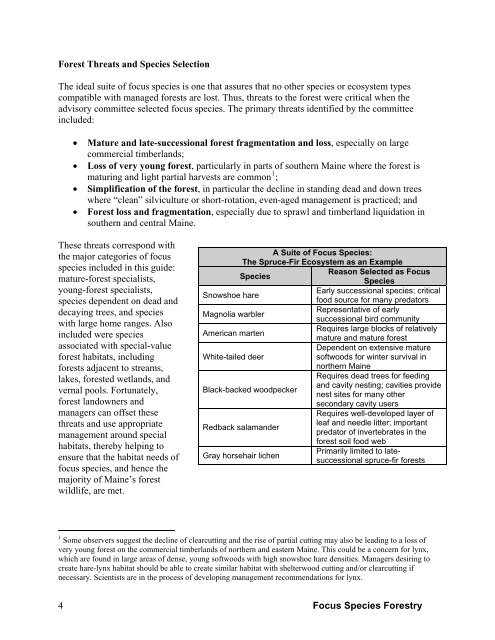
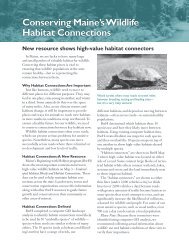
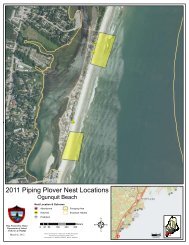

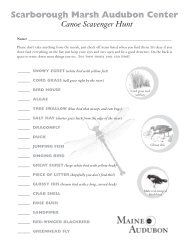


![2012 Loon Count Results [pdf] - Maine Audubon](https://img.yumpu.com/26228732/1/190x245/2012-loon-count-results-pdf-maine-audubon.jpg?quality=85)
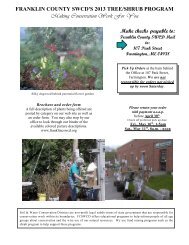
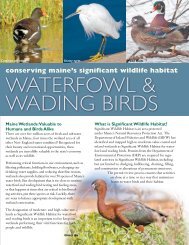
![Lake Fish of Maine (DIFW list) [pdf] - Maine Audubon](https://img.yumpu.com/23282964/1/190x245/lake-fish-of-maine-difw-list-pdf-maine-audubon.jpg?quality=85)
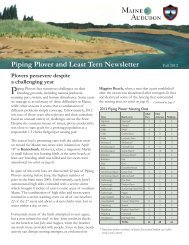

![The Maine Audubon Peony Circle of Friends 2012 [pdf]](https://img.yumpu.com/22707677/1/190x253/the-maine-audubon-peony-circle-of-friends-2012-pdf.jpg?quality=85)
